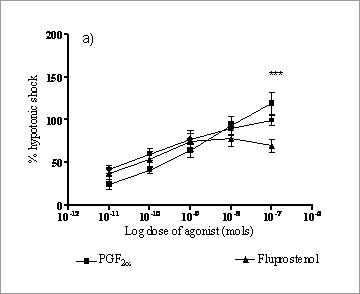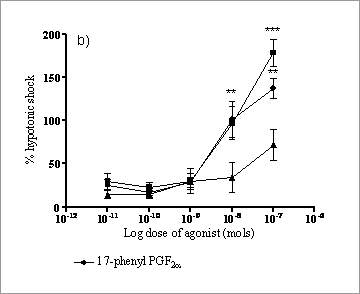The FP-receptor population in the mouse isolated uterus Previous studies have demonstrated a functional prostaglandin F2α-receptor (FP) population on isolated mouse uterus (Griffiths et al., 2006). The aim of this study was to investigate the FP population further using PGF2α, selective FP analogues (fluprostenol and 17-phenyl PGF2α) and an FP antagonist, AL-8810 (Griffin et al., 1999). Female BKW mice were sacrificed either during dioestrous or on day 18 of gestation. Uterine tissue samples were taken and set up for superfusion (Krebs’ solution at 2ml/min at 37oC) as previously described by Griffiths et al (2006). After 30 minutes equilibration, agonists were added as bolus doses. When used the antagonist was infused for a 30-minute period prior to agonist administration. Responses were measured as the area under the curve and expressed as a percentage of the reference contraction (hypotonic shock). Data were expressed as arithmetic mean ± S.E.M., n=6 and statistically analysed using a two-way ANOVA with Bonferroni post hoc test.
Figure 1. Dose-response curves to FP agonists on a) non-gestational and b) gestational tissues. PGF2α compared to 17-phenyl PGF2α and fluprostenol.
All the agonists were excitatory. PGF2α (P<0.001) and 17-phenyl PGF2α (P<0.01) elicited greater responses than fluprostenol and this difference was most marked at late gestation (figure 1). The antagonist AL-8810 (1μM) had no effect on the response to PGF2α in non-gestational tissue but in tissue taken at late gestation the maximum response to PGF2α was significantly enhanced (P<0.05). These data are consistent with the up-regulation of the FP receptor at late gestation (Cook et al., 2003). The enhanced responses seen with higher doses of PGF2α and 17-phenyl PGF2α may indicate they are acting on more than one receptor. The absence of inhibition seen with AL-8810 suggests that the compound is acting as a partial agonist at late gestation (Griffin et al., 1999).
Cook, J.L. et al., (2003). Biol . Repro. 68 (2) 579-587 |
|



